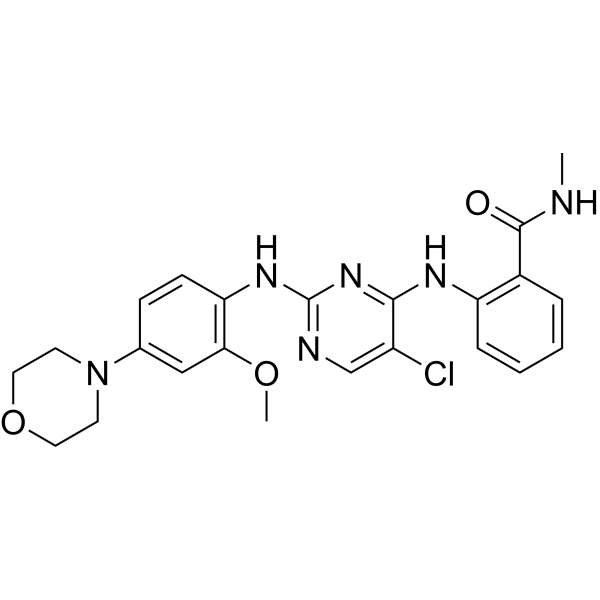Home
Products
TAE226 (NVP-TAE226)



| Product Name | TAE226 (NVP-TAE226) |
| Price: | Inquiry |
| Catalog No.: | CN00194 |
| CAS No.: | 761437-28-9 |
| Molecular Formula: | C23H25ClN6O3 |
| Molecular Weight: | 468.94 g/mol |
| Purity: | >=98% |
| Type of Compound: | Alkaloids |
| Physical Desc.: | Powder |
| Source: | |
| Solvent: | Chloroform, Dichloromethane, Ethyl Acetate, DMSO, Acetone, etc. |
| SMILES: | CNC(=O)c1ccccc1Nc1nc(ncc1Cl)Nc1ccc(cc1OC)N1CCOCC1 |
| Contact us | |
|---|---|
| First Name: | |
| Last Name: | |
| E-mail: | |
| Question: | |
| Description | NVP-TAE 226 is a dual tyrosine kinase inhibitor of FAK (IC50=5.5 nM) and IGF-IR (mean IC50=0.14 μM). |
| Target | IC50: 5.5 nM (FAK), 3.5 nM (Pyk2), 0.14 μM (IGF-IR), 0.16 μM (c-Met), 0.36 μM (KDR), 0.48 μM (Flt3)[1] |
| In Vitro | NVP-TAE 226 (TAE226), a potent ATP-competitive inhibitor of several tyrosine protein kinases, in particular FAK and IGF-IR kinases. In a cell-based kinase assays, FAK, IGF-IR kinase, and IR kinase are inhibited with an IC50 range of 100 to 300 nM compared with the other kinases tested, which are >10-fold less sensitive. In culture, NVP-TAE 226 inhibits extracellular matrix-induced autophosphorylation of FAK (Tyr395). NVP-TAE 226 also inhibits IGF-I-induced phosphorylation of IGF-IR and activity of its downstream target genes such as MAPK and Akt. NVP-TAE 226 retards tumor cell growth as assessed by a cell viability assay and attenuates G2-M cell cycle progression associated with a decrease in cyclin B1 and phosphorylated cdc2 (Tyr15) protein expression. NVP-TAE 226 treatment inhibits tumor cell invasion by at least 50% compared with the control in an in vitro Matrigel invasion assay. Interestingly, TAE226 treatment of tumor cells containing wild-type p53 mainly exhibits G2-M arrest, whereas tumor cells bearing mutant p53 underwent apoptosis[1]. |
| In Vivo | Treatment with NVP-TAE 226 (TAE226) at 50 or 75 mg/kg extends the median survival of U87 xenograft animals by 6 and 7 days, respectively (P=0.084 and P=0.042, respectively, compared with vehicle-treated animals). However, NVP-TAE 226 treatment of LN229-engrafted animals significantly prolongs their median survival by 19 days (P<0.004 for both dosages, compared with vehicle-treated animals)[1]. |
| Cell Assay | Glioma cell cultures are harvested with 0.05% trypsin and seeded in triplicate at 2×104 in 24-well culture plates for 24 h before drug treatment. Culture medium is used for mock treatment. Cells are harvested at the indicated day after treatment, and viable cells are counted using the Vi-cell viability analyzer. The antiproliferative activity of NVP-TAE 226 (ranging from 0.25 to 1 μM) on cells growing in culture is determined using a tetrazolium-based colorimetric MTT assay[1]. |
| Animal Admin | Mice[1] Male nude mice used for this study are 6 to 8 weeks old. In DMEM/F12 serum-free media (5 μL), 5×105 of U87 cells and 1×106 of LN229 cells per mouse are implanted intracranially through a guide-screw system. Four days after injection of the tumor cells, mice are randomized into three groups for each cell line (n=6). Mice in group 1 are treated with 50 mg/kg NVP-TAE 226 in 200 μL of 0.5% methylcellulose, via an oral gavage. The mice in group 2 receive 75 mg/kg NVP-TAE 226 in 200 μL of 0.5% methylcellulose. The mice in group 3 the same vehicle used for administration of NVP-TAE 226 (control). Treatment frequency is once a day for 5 days and off for 2 days, for a duration of 4 weeks. Mice are monitored daily. Mice are euthanized when they are moribund, and the whole brain is extracted for rapid freezing in liquid nitrogen and storage at -70°C. |
| Density | 1.3±0.1 g/cm3 |
| Exact Mass | 468.167664 |
| PSA | 100.64000 |
| LogP | 2.35 |
| Storage condition | -20℃ |